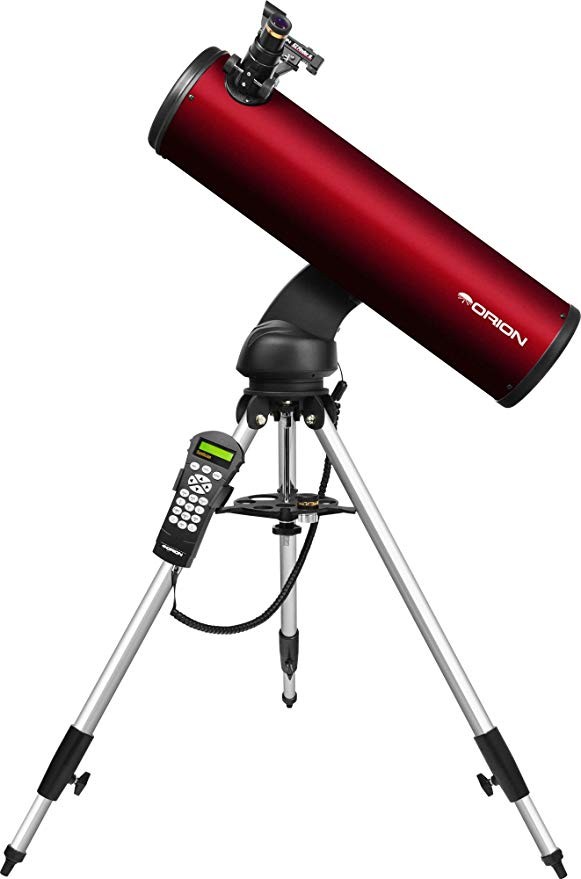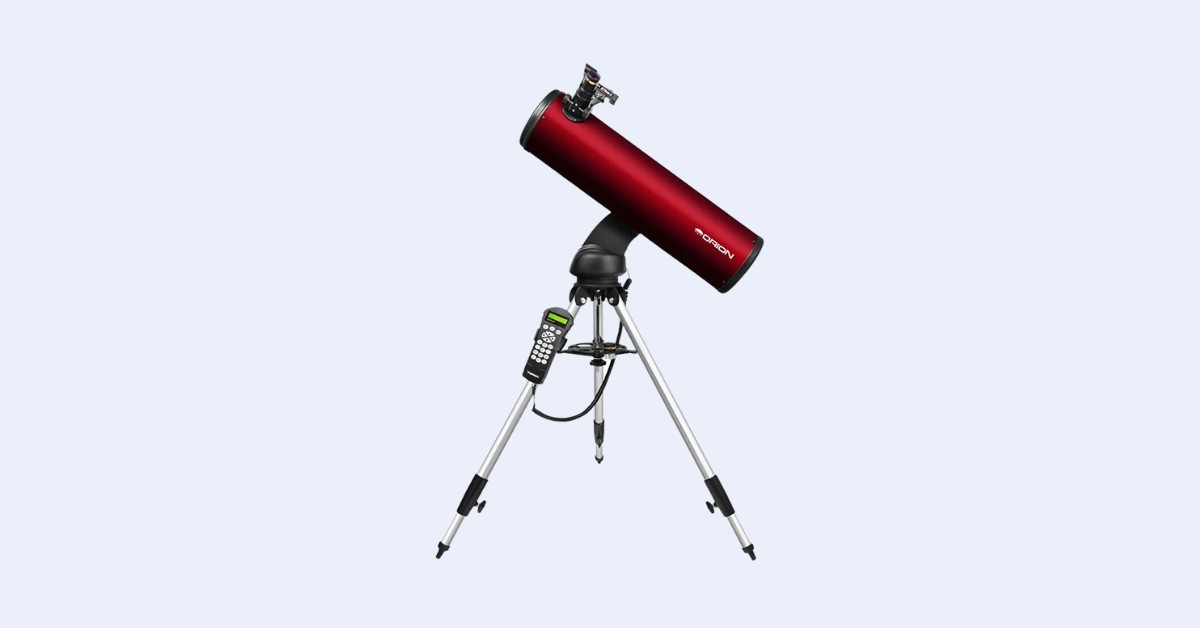The Optical Tube Of StarSeeker IV
The StarSeeker IV 150mm Reflector is a 6” f/5 Newtonian with a 750mm focal length. I’ve found these to be fairly common scopes, especially for beginning visual users or astro-imagers. However, the scope deviates from most of the common 6” Newtonians out there in the form of the primary mirror cell.

The primary mirror cell of the StarSeeker IV 150mm is made entirely of plastic, and has a closed back so the mirror cannot cool down as quickly as a regular, open cell. But more seriously, I’ve observed that there are no collimation adjustments of any kind. This means that if your scope is out of collimation, there is really nothing that can be done about it. There are some DIY solutions to fix the collimation using the screws holding the cell to the tube walls, but these will only work for minor tweaking and are not convenient in the field. It seems that the scope does a decent job holding collimation, but buyer beware.
Despite all this, I find the views pretty good – no different from any other mass-produced 6” f/5 Newtonian. If I didn’t know about the odd secondary spider and primary cell and was looking through it I’d probably tell you there was nothing unusual about the optics.
The focuser on the StarSeeker IV 150mm Reflector is a 1.25” unit, made almost if not entirely of plastic. It works acceptably, though it will present some wiggle if you attach a heavy camera or eyepiece. Replacing it with a quality Crayford focuser requires some comfort with making modifications to the telescope and removing the optics, but can be done relatively easily.
The StarSeeker IV 150mm Reflector optical tube attaches to the StarSeeker IV mount with a short Vixen-style dovetail.
Reviewing the Accessories
The StarSeeker IV scopes all come with 23mm and 10mm aspheric eyepieces with a 62-degree apparent field of view, providing 33x and 75x respectively. These eyepieces use two glass lens elements and an aspheric plastic lens element. Surprisingly, they actually work really well (particularly the 23mm) and are actually a cut above the cheap Kellners or plastic Plossls supplied with many entry-level scopes. However, the scope would certainly benefit from real Plossl or wide-angle eyepieces, and are kind of a letdown for a $600+ telescope.
The scope also includes a standard red-dot finder for aligning the SynScan GoTo system. It attaches to the optical tube with a standard Vixen/Synta-style shoe, so most finderscopes can be installed in its place should you find the need to do so.
Mount Performance
The StarSeeker IV mount is fairly standard as far as cheap altazimuth GoTo mounts these days go – internals with gears that may or may not be plastic, simple motors, an 8-AA battery power pack, and stainless steel legs. However, the StarSeeker IV mount adds a notable improvement with its dual optical encoders. Orion simply refers to them as dual optical encoders, but Sky-Watcher brands them with the flashier name of “FreedomFind technology”. Regardless of what you prefer to call it, these encoders allow you to move the scope manually without ruining the GoTo alignment. This is great if you or someone else accidentally move the telescope, if you just want to move around the sky manually, or if you want to save power by manually moving the scope to the general area of sky you are observing in next and using the GoTo to fine-tune your pointing. This same tech is used on Orion and Sky-Watcher’s GoTo Dobsonians and I find it to be a fantastic convenience.
The StarSeeker IV also has a built-in WiFi module. This means that you can control the telescope and see where it is pointed using SkySafari or the free SynScan Pro app, allowing for a much more user-friendly interface than the included hand controller.
What can you see?
Within the Solar System, the StarSeeker IV 150mm is capable of showing you a lot – though you’ll probably want additional eyepieces for higher magnification than the mere 75x of the stock 10mm for the best views.
The Moon shows details down to a few miles across, as with almost any good telescope. We don’t need to tell you how good the views are – you have to see them for yourself.
Venus and Mercury show nothing more than their phases, as is the case with even the best instruments.
Mars is often proclaimed to be always disappointing by many amateurs, but the StarSeeker IV 150mm will have no trouble showing you its dark albedo features and ice caps for the short window of time when Mars is around opposition and closest to Earth every 2 years.
Saturn has a few visible, albeit low-contrast – cloud bands, as well as the Cassini Division in its rings, and several moons, including its largest, Titan, which is easy to spot and looks yellow-orange.
Uranus’ moons are outside the reach of the StarSeeker IV, but the planet itself can be seen as a turquoise ball. Neptune is a blue star-like dot and its moon Triton can just barely be seen on a good night.
Besides the Moon and planets, the StarSeeker IV 150mm is great for viewing deep-sky objects – it’s what you want the GoTo for, after all. The 150mm aperture is enough to start resolving individual stars in bright globular clusters like M3, M13, M92, M15, M5, and M2, and you can spot almost all of the dimmer Messier globulars and a few of the NGC ones as well. A few galaxies such as M82 show discernable detail, and thousands are visible as dim smudges under dark skies. And, of course, bright nebulae like Orion, the Swan, and the Lagoon are no trouble and will look fantastic under even mediocre conditions, along with planetaries like the Ring and Dumbbell Nebulae.
Alternative Recommendations
Numerous GoTo and manual scopes of equal or greater aperture to the StarSeeker IV 150mm are available – such as 5-6” tabletop Dobsonians, 8” and larger Dobsonians with greater light-collecting and resolving power, or a computerized catadioptric instrument. We would highly recommend considering one of these options instead of the StarSeeker IV 150mm.
Under $600
- Computerized Scope (Best): Sky-Watcher Virtuoso GTi 150P provides almost the exact same features as the StarSeeker IV 150mm, including motorized GoTo/tracking capabilities, the ability to be aimed manually and controlled via WiFi, and 6” f/5 optics, and the bonuses of actual collimation adjustment and a collapsible tube for easy portability. It also includes better kit eyepieces, is portable, and a heck of a lot cheaper.
$600-$800
- Manual Scope (Best Value): The Apertura AD8/Zhumell Z8/Orion SkyLine 8 easily bests the StarSeeker IV 150mm with its impressive light gathering capabilities – nearly twice that of a 150mm (6″) scope – and a dual-speed 2” Crayford focuser, built-in fan, and numerous supplied accessories – making it an excellent choice and our top pick in its price range.
- Partially Computerized Scope: The Celestron StarSense Explorer 8” Dobsonian is fairly lightweight and easy to transport. It also comes equipped with a smart StarSense Explorer system that can help guide you around the night sky; however, additional eyepieces/accessories are required.
$800-$1200
- Manual Scope (Best Value): The Apertura AD10/Zhumell Z10/Orion SkyLine 10 has the same fantastic accessories, features, and value for the money as its smaller brother, with the 10” optical tube and base weighing in at just a bit more than the AD8/Z8 and not much more difficult to store or transport, despite offering significantly more light-collecting and resolving power.
- Partially Computerized Scope: The Celestron StarSense Explorer 10” Dobsonian gives you the same great StarSense Explorer technology as the 8” model, but with more aperture and an easier collimation. With its lightweight and ergonomic design, it is significantly easier to set up and transport than many other 10″ Dobsonians.
- Computerized Scope: The Celestron NexStar 6SE offers many of the same features and design aspects of the StarSeeker IV 150mm but is a Schmidt-Cassegrain with twice the focal length and features a hand controller rather than WiFi connectivity by default. You also cannot aim it manually. However, it’s still a high-quality scope and definitely worth considering if you must have a tripod-mounted GoTo instrument.
Aftermarket Accessory Recommendations
The StarSeeker IV 150mm’s 1.25”-only focuser limits it somewhat in terms of low-power options, but a quality 24/25mm wide-field eyepiece (31x or 30x) or 32mm Plossl (23x) would get you a slightly wider field of view than the included 23mm aspheric eyepiece. A 6mm “gold-line” will provide 125x, significantly more than the mere 65x of the included 10mm and a far more appropriate magnification for viewing smaller lunar details, the planets, globular clusters, and tight double stars. For even more magnification, you could add a 2x Barlow lens to get 130x with the 10mm and 250x with the 6mm goldline, the latter of which is close to the limit of what the scope can handle.
Another item we’d recommend is a power supply. Don’t splurge on anything really expensive – the TalentCell 6000mah rechargeable one is plenty.



